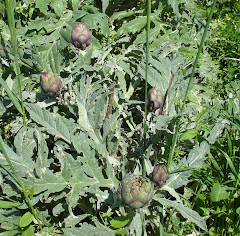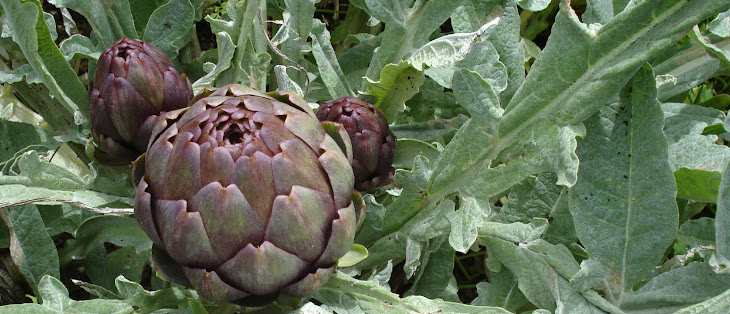There seems to be so much to do in the garden at the moment ... watering, because the weather is suddenly hot and we've had very little rain for weeks, planting out lettuce seedlings, sowing other salad plants, preparing the ground for the pepper and tomato plants, having lunch ... and so on.
Il y a beaucoup de travail au jardin en ce moment ... l'arrosage, parce qu'il a commencé de faire chaud et il n'a pas plu pour quelques semaines, repiquer les salads, semer les autres salades, préparer la terre pour les poivrons et les tomates, manger le déjeuner ... etc.
I've repotted over 60 tomato plants (more than we'll need, but they're growing very slowly, so maybe they won't all survive) and some of the courgettes which already have quite large root systems.
J'ai repiqué plus de 60 plantes de tomates et quelques uns de courgettes qui ont déjà des longues racines.

Over the past couple of weeks the garden has become a very noisy place as the bees buzz around the rosemary and the broad bean flowers. / Pendant les semaines dernières le jardin est devenu très bruyant avec les abeilles qui bourdonnent autour des fleurs du romarin et des fèves.

And on this broad bean flower there's one of the big flying black beetles which are very common in our garden.

The second (February) sowing of broad beans are coming up well. I'm specially pleased with these as they were seeds we saved a few years ago and had forgotten about!
Spring salad / salade du printemps

Rocket, wild rocket, oregano and sorrel leaves / les feuilles de la roquette, la roquette sauvage, oreganum et oseille.
Wild asparagus / les asperges sauvages

A friend had given us some spears of wild asparagus she had picked and we added some spears from plants growing wild in our garden. Wild asparagus is thinner than the cultivated variety, with a herby, more concentrated flavour. It grows in the garrigue, especially where there has recently been a fire so that it has less competition from other bigger plants. Here the tradition, especially on Easter Monday, is to go for a walk in the garrigue and pick asparagus and then make omelette with it. We did this in the garden today.
Les asperges sauvages poussent dans la garrigue. Elles sont plus fines que la varieté cultivée et elles ont un gout concentré. Il y a une tradition ici d'aller dans les garrigue le lundi de Paque pour ramasser les asperges et puis de faire une omelette aux asperges. On l'a fait au jardin aujourd'hui.
Pepper germination / germination de poivrons
We've had very high germination rates for most of the varieties we've sown. All these seeds came from Kokopelli except the Long d'Espagne which our neighbour gave us.
Corno di Toro: 100 % Italian Red Marconi: 100%
Lipstick: 100% Kolaska: 100 %
Kandil Dolma: 60 % Nardello: 100 %
Long d'Espagne: 10 % (but these seeds were a few years'old)
Yellow cornos (from Kate) and chilli peppers (our own saved seed) were sown later and have not yet germinated.
The problem with the peppers now is to keep them at a consistently high enough temperature and give them enough light. Today we put some of them out on the balcony under polythene, but some of them got a bit too hot and dry. I think they'll be OK.
The apricot blossom is over now, and the cherry blossom is here ... / Les fleurs d'abricotier sont finis maintenant, et les fleurs de cerisier arrivent ...

Cherry blossom opening on a tree near our garden - the tree is on public ground, so we'll keep an eye out for the fruit in May. |  |

























































